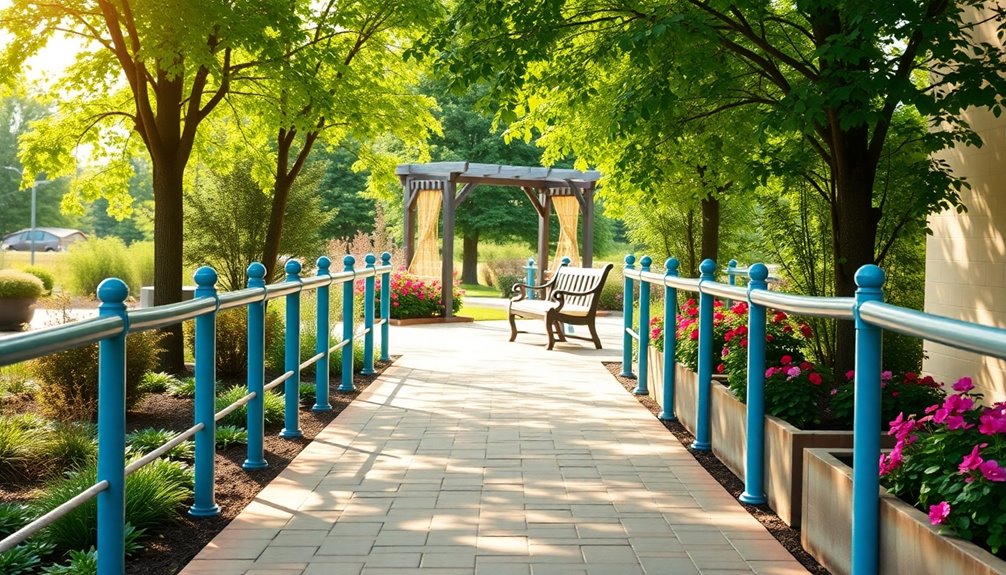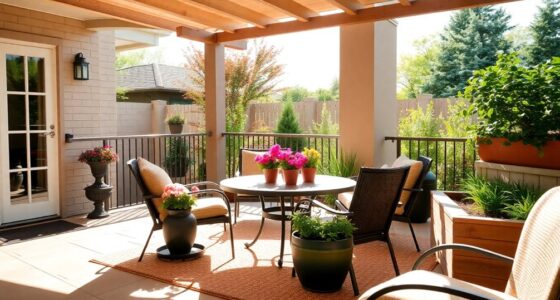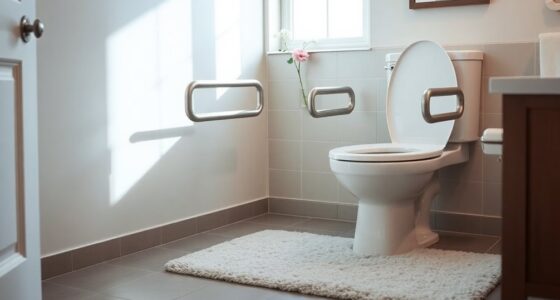To create safe outdoor walkways for seniors, start by evaluating and modifying existing pathways for any hazards. Enhance stability with handrails and non-slip surfaces. Improve lighting by adding motion sensors and high-contrast designs. Focus on slip and fall prevention with grip-enhancing materials and regular debris removal. Finally, maintain clear and well-defined pathways with smooth materials and visual boundaries. For more tips on creating a safer environment, check out additional resources and strategies.
Key Takeaways
- Assess and modify walkways to ensure a minimum width of 36 inches and check for cracks or uneven surfaces regularly.
- Install handrails or grab bars for support, and use non-slip coatings to enhance traction on pathways.
- Improve lighting with a combination of fixtures and motion sensors to enhance visibility and safety during nighttime.
- Prioritize slip and fall prevention by using slip-resistant materials and regularly removing debris like leaves and branches.
- Clearly define pathway boundaries with contrasting colors or materials to guide seniors safely along the walkways.
Assess and Modify Walkways for Safety

When you assess and modify walkways for safety, it's crucial to start with a thorough evaluation of your current pathways.
Check if they meet the recommended minimum width of 36 inches, ensuring ample space for mobility aids like walkers and wheelchairs.
Regularly inspect the surfaces for cracks, potholes, and uneven terrain, addressing any tripping hazards immediately to prevent falls.
Clear obstacles and debris, such as loose stones or fallen leaves, to maintain safe walking routes in outdoor spaces for seniors. Additionally, consider incorporating wider pathways and handrails in outdoor areas to further facilitate mobility and ensure safety. Providing access to ergonomic gardening tools for seniors can also encourage them to engage with nature while minimizing strain on their bodies. By creating a more accessible environment, we promote not only safety but also overall well-being and enjoyment of outdoor activities for the elderly.
Implement a routine maintenance schedule to repair damaged surfaces and regularly check for potential hazards.
You might also consider widening narrow walkways by removing unnecessary furniture or landscaping features to promote safe navigation and enhance accessibility.
Enhance Accessibility and Stability
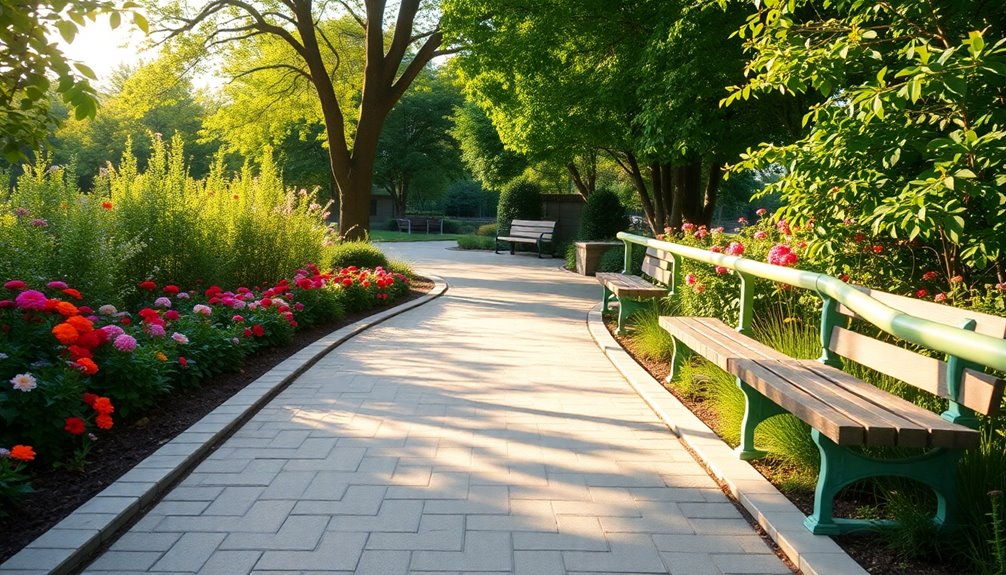
To enhance accessibility and stability along outdoor walkways, it is vital to focus on features that directly support seniors as they navigate their environment. Installing handrails or grab bars can provide significant support, especially on uneven surfaces. Make certain your walkways are wide enough to accommodate mobility aids like walkers and wheelchairs, measuring at least 36 inches in width. Additionally, using non-slip coatings on surfaces enhances traction, reducing slips. Regular maintenance to fix cracks and clear debris keeps outdoor areas safe and accessible. Furthermore, ensuring proper drainage is important to prevent overwatering issues that can create slippery conditions.
| Feature | Benefits |
|---|---|
| Handrails/Grab Bars | Provides important support for stability |
| Minimum 36-inch Width | Accommodates mobility aids for safe passage |
| Non-slip Coatings | Improves traction in wet conditions |
| Regular Maintenance | Preserves safety by addressing hazards |
Improve Lighting and Visibility
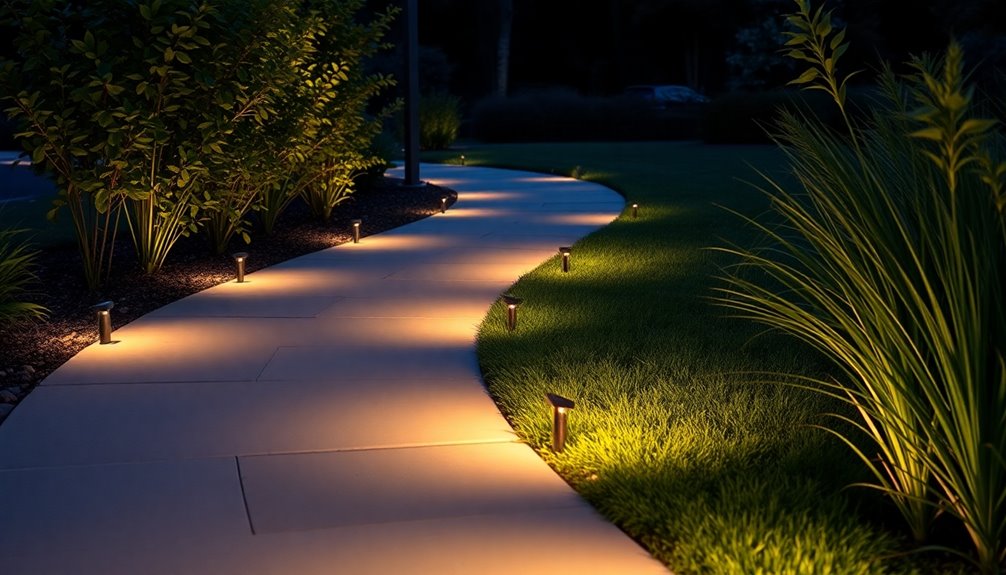
Good lighting is essential for creating safe outdoor walkways for seniors. Installing a mix of overhead lights, wall-mounted fixtures, and solar-powered pathway lights greatly boosts visibility, reducing the risk of falls when maneuvering at night.
Consider adding motion sensor lights to automatically illuminate pathways as someone approaches, ensuring safety without wasting energy. Regularly check and maintain all lighting fixtures to confirm functionality, keeping key areas well-lit and preventing accidents in dim spaces.
High-contrast lighting designs, like strategically placed lights that highlight pathway edges and elevation changes, help seniors identify potential hazards. A well-lit outdoor environment not only enhances visibility but also fosters a sense of security, allowing seniors to navigate their surroundings with confidence.
Prioritize Slip and Fall Prevention
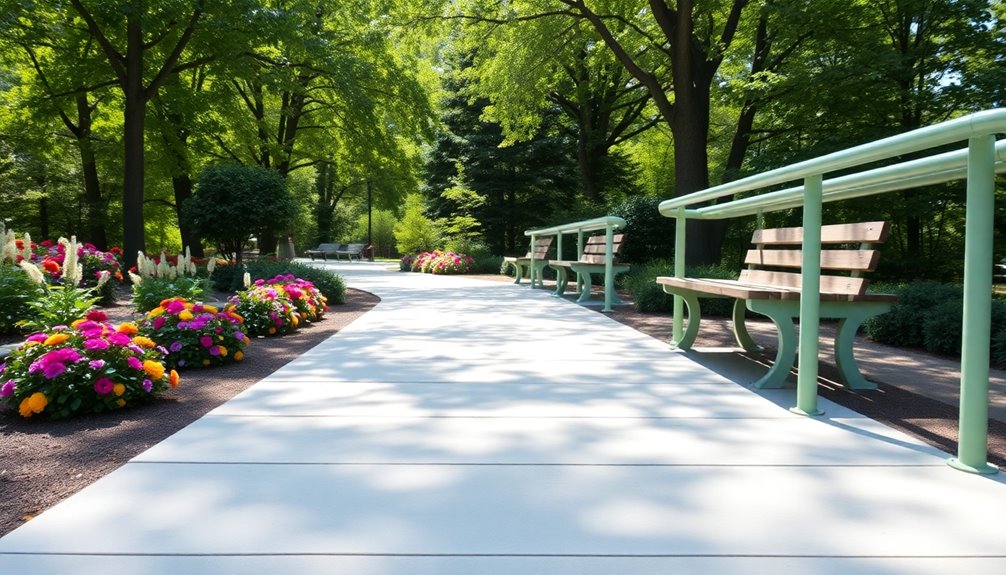
Prioritizing slip and fall prevention is crucial for ensuring seniors can navigate outdoor walkways safely.
To effectively reduce the risk of accidents, you should focus on the following strategies:
- Use grip-enhancing, slip-resistant materials for all outdoor surfaces.
- Conduct regular inspections to identify and address trip hazards like loose stones and uneven surfaces.
- Secure outdoor rugs and mats with double-sided tape or slip-resistant pads to prevent movement.
- Remove fallen leaves, branches, and debris immediately to eliminate slippery conditions.
Maintain Clear and Well-Defined Pathways
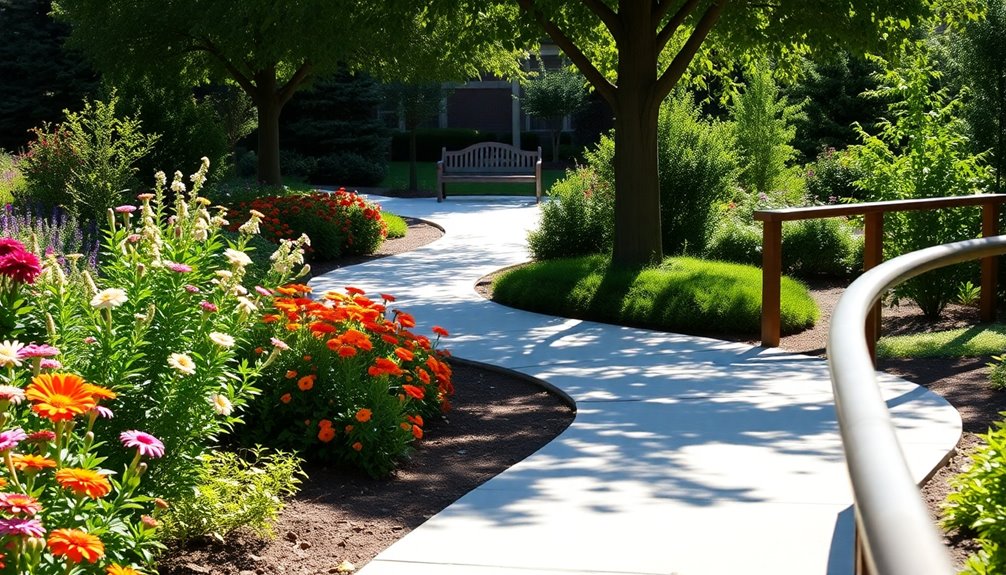
Creating clear and well-defined pathways is essential for seniors to navigate outdoor spaces safely.
Make certain pathways are wide enough—at least 36 inches—to accommodate mobility aids like wheelchairs and walkers.
Regularly inspect and maintain these pathways by removing debris and repairing cracks to guarantee proper safety and comfort.
Opt for smooth, slip-resistant materials like textured paving stones or concrete to reduce the risk of falls.
Enhance visibility with well-placed lighting fixtures, including solar-powered and motion sensor lights, to ensure safety during low-light conditions.
Finally, clearly define pathway boundaries using contrasting colors or materials.
This helps seniors navigate more easily and identify potential hazards, creating a safer outdoor environment for everyone. Additionally, consider incorporating emergency fund measures that help provide financial stability for necessary maintenance and upgrades to these walkways.
Frequently Asked Questions
How to Make Steps Safe for the Elderly?
To make steps safe for the elderly, you should guarantee that each step has a uniform height and depth, ideally between 4 to 7 inches high and 11 to 14 inches deep.
Install sturdy handrails on both sides, positioned at 34 to 38 inches high. Use non-slip materials on the surfaces, paint step edges with high-contrast colors, and maintain adequate lighting.
Regularly inspect for cracks or debris to prevent tripping hazards and guarantee safety.
How Do You Secure an Elderly Home?
So, you think securing an elderly home is just locking the door and calling it a day? Not quite!
Start by evaluating potential hazards like uneven surfaces or loose rugs that could lead to unfortunate trips. Install grab bars in bathrooms and guarantee outdoor areas are well-lit.
Keep pathways clear of clutter, and consider a security system for peace of mind.
Conclusion
By following these five simple steps, you can transform outdoor walkways into safe havens for seniors. Imagine the peace of mind that comes with knowing every step they take is secure. Picture the joy of a stroll without fear of slips or falls. But don't stop here—keep evaluating, enhancing, and maintaining those pathways. The safety of your loved ones hinges on your commitment. So, are you ready to take the next step toward a safer outdoor experience?
